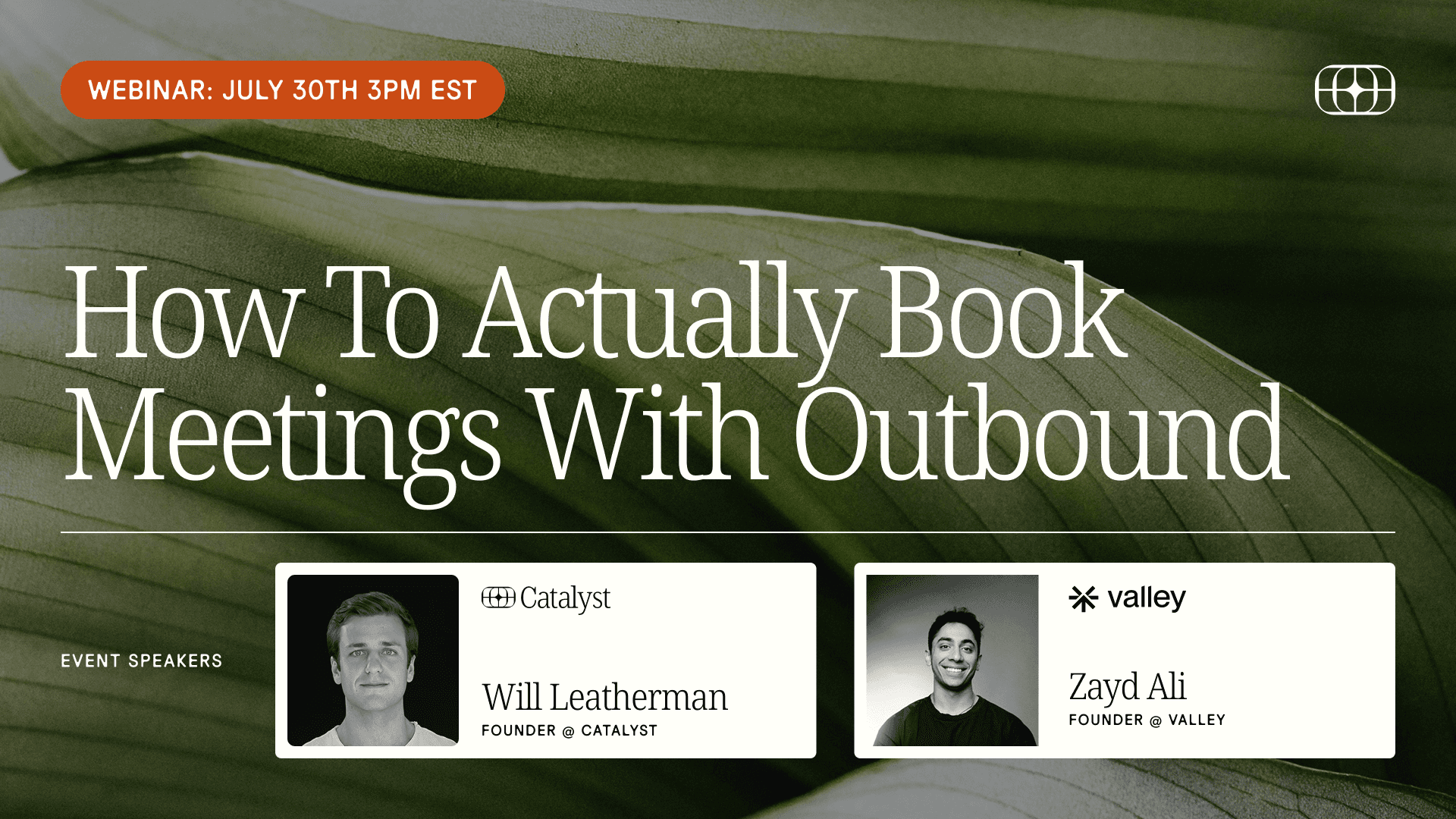
How to build a $1.5M monthly pipeline engine with warm outbound
Cold outbound is broken. Let's not pretend otherwise. The endless "shoot from the hip" emails, the 1% reply rates, the constant fight for a sliver of attention... it's an exhausting, inefficient grind.
Your pipeline is hiding in plain sight
What if you could tap into a system that generates a $1.5 million monthly pipeline, books over 300 meetings for the sales team, and fills your Account Executive's calendar two weeks in advance, all without a single cold call?
This is the reality of the Warm Outbound Engine.
Your ideal customers are already signaling their interest every day through their "digital body language." They visit your profile, follow your company page, engage with your posts, and even lurk on your website's pricing page. Those vanity metrics you see? They're actually a hidden pipeline of warm, high intent leads waiting to be engaged.
This playbook provides the exact four step framework to systematically capture these signals and turn them into a predictable stream of qualified demos. We've used this to scale our own LinkedIn outreach to 130 to 140 demos every month. It's time to stop guessing and start building a machine that converts attention into revenue.
From cold interruptions to warm conversations
The GTM landscape has changed. Buyers are more informed and resistant to generic, cold interruptions than ever before.
According to HubSpot's 2024 Sales Trends, warm outreach based on intent signals can achieve 30 to 50% higher response rates compared to traditional cold outbound. LinkedIn's own 2023 State of Sales Report found that sales professionals who leverage social selling are 51% more likely to hit their quota.
The logic is simple: you're no longer a stranger. By engaging based on an action they've already taken, you have context, relevance, and timing on your side.
What are LinkedIn intent signals?
These are the digital breadcrumbs your prospects leave behind that indicate interest or curiosity.
Your job is to collect them. The core signals for this engine include profile visitors (people who have recently viewed your personal LinkedIn profile), profile followers (new individuals who have chosen to follow your personal content), company page visitors and followers (prospects who have checked out or followed your official company page), post engagement (anyone who has liked, commented on, or shared your posts, or even your competitors' posts), and website visitors (using tools to de-anonymize traffic, you can identify which companies are visiting your site, especially high intent pages like pricing or case studies).
Accumulating these signals is the first step. The magic happens when you process them through our proven framework.
The 4 step warm outbound framework: scrape, qualify, segment, outreach
The entire system boils down to a simple, repeatable four step process. Mastering this flywheel is how you build a scalable demo booking machine.
Scrape: systematically collect all relevant intent signals from various sources.
Qualify: enrich the data and filter it against your Ideal Customer Profile (ICP) to separate the signal from the noise.
Segment: group qualified leads based on the strength of their intent signal to tailor your outreach.
Outreach: engage with timely, relevant, and respectful messages that convert.
Let's dive deep into each step.
Step 1: scrape (harvesting your hidden pipeline)
Your first task is to become a master harvester of attention. You need a system to capture every relevant signal before it goes stale.
What to scrape
Daily list of your new profile viewers. Daily list of new personal followers. Daily or weekly list of new company page followers. Engagers on your last 3 to 5 high performing posts. Engagers on 1 to 2 key competitors' recent posts. De-anonymized company traffic from your website (especially pricing and demo pages).
How to scrape it
Manual (the scrappy start): You can start by manually checking your "Who's Viewed Your Profile" page daily and copy pasting the URLs into a Google Sheet. It's tedious but costs nothing.
Automated (the scalable method): Use a tool like PhantomBuster. You can set up "Phantoms" to automatically scrape your profile viewers, followers, and post engagers daily and export the data directly to a Google Sheet. This is the key to making the system scalable and consistent.
At the end of this stage, you should have a constantly updated spreadsheet or database filled with the LinkedIn profile URLs of people who have shown some level of interest.
Step 2: qualify (finding the gold in the stream)
Not every signal is created equal. A college student who viewed your profile is not the same as a VP of Engineering at a target account. This step is about filtering for your ICP.
Enrich the data
Your scraped list likely only has names and LinkedIn URLs. You need more context. Use an enrichment tool to find their job title, company, company size, industry, and email address. Tools like Prospio are great, affordable options. Other powerful tools include Apollo.io, Clay, or Clearbit.
Score for ICP fit
Once enriched, score each lead against your ICP criteria. You can do this in a spreadsheet with simple formulas or more advanced tools.
Example scoring: Title matches target persona? Add 5 points. Company size within target range? Add 3 points. Industry is a target vertical? Add 2 points.
A simple score helps you prioritize who is a "high fit" vs. "low fit" ICP. This prevents your team from wasting time on unqualified prospects. G2's 2024 Sales Intelligence Report shows that enriched leads have a 25% higher qualification rate, making this step crucial for efficiency.
Step 3: segment (the art of timing and context)
This is where most teams fail. They treat every signal the same. A profile view is not the same as a 3 minute visit to your pricing page. As the guest from Valley noted, "if they were on your pricing page for 3 minutes, they're seriously in the buying journey."
Segmenting by behavior allows you to match your message to their buying intent. A 2024 Demand Gen Report study confirms that personalized outreach based on segmented intent data yields 20% higher close rates.
Here's a simple segmentation ladder:
Tier 1 (high intent, contact within 24 hours): Signal is visited pricing page, demo request page, or spent significant time on key case studies. Mindset is they are actively in a solution exploration phase.
Tier 2 (medium intent, contact within 1 to 3 days): Signal is followed your company page, engaged with multiple posts over a week, or visited your website's homepage. Mindset is they are problem aware and your brand is on their radar.
Tier 3 (low intent, contact within 1 week or add to nurture): Signal is viewed your profile once, liked a single top of funnel post, or followed your personal profile. Mindset is they are passively curious. The goal is to build a connection, not force a meeting.
Step 4: outreach (from signal to conversation)
Now that you have scraped, qualified, and segmented your leads, it's time for the outreach. Think warm, contextual, and respectful outreach designed to start conversations. The goal is a 30 to 60% reply rate, which is unheard of in traditional outbound.
The golden rule: lead with value, not an ask
Never just add someone to an automated email sequence. Instead, offer a piece of value that aligns with their inferred intent. As the guest from Valley explained, "send them a checklist. In Valley's case, we have just built like a simple tool to calculate your ROI." This consent first approach respects the buyer and increases opt in rates by 20 to 30%.
Outreach angles by segment
For high intent leads (tier 1): Channel is LinkedIn message plus email. Angle is be direct but helpful. You have permission to be more forward because their actions indicate urgency.
Template: "Hi [Name], saw that [Company] was spending some time on our pricing page. Usually when folks are looking there, they're comparing options for [solving X problem]. I recorded a quick 2 minute Loom video outlining how we're different from [Competitor] on that front. No pressure to watch, but thought it might be helpful. Let me know if a quick 15 min call to discuss would be useful."
For medium intent leads (tier 2): Channel is LinkedIn message. Angle is reference their engagement and offer a relevant resource.
Template: "Hey [Name], appreciate you following our page / engaging with my post on [topic]. Since you're interested in that, you might find this one pager on [related topic] useful. It breaks down the framework we use to achieve [result]. Happy to send it over if you're interested."
For low intent leads (tier 3): Channel is LinkedIn connection request. Angle is simple, low pressure connection.
Template: "Hi [Name], noticed you viewed my profile and that we're both in the [industry] space. Would be great to connect and follow your work."
This methodical approach is how you achieve 60% reply rates and 100% connection acceptance rates on some campaigns. Be a helpful resource rather than a pushy salesperson.
Your tech stack: from scrappy to scaled
You can run this playbook with any budget.
The scrappy stack (under $100/mo)
Scraping: manual copy paste or a single PhantomBuster plan.
Enrichment and qualification: Google Sheets with formulas plus a Prospio plan.
Outreach: manual outreach via LinkedIn.
The automated stack ($200 to $500/mo)
Scraping: PhantomBuster (multiple phantoms).
Enrichment and logic: Clay.com (to orchestrate enrichment and segmenting).
Outreach: an outreach tool like LaGrowthMachine or Salesloft.
The all in one platform
Valley: Platforms like Valley are designed to do all of this in one place. As the guest shared, "In the last seven days, I've already booked four demos from my own account. 47 were identified and a few of them are high fits. Send them really high quality personalized outreach." This consolidates the stack and streamlines the entire workflow.
Stop wasting attention, start booking meetings
The Warm Outbound Engine represents a fundamental shift in how you approach pipeline generation. It bridges the gap between marketing's content efforts and sales' need for qualified meetings. It respects the buyer, leverages modern tools, and creates a predictable, scalable system for growth.
You are already generating the signals. Your ideal customers are already raising their hands. It's time to stop ignoring them.
Implement this four step playbook (scrape, qualify, segment, and outreach) and you will transform your LinkedIn presence from a vanity channel into your most powerful pipeline engine.
Enjoyed this playbook? We host live sessions with top GTM leaders to break down their strategies. Click here to join the next one.
Need help with your GTM aligned content?
About the speaker
Shubh Agrawal
GROWTH @ VALLEY
Download Playbook
By downloading, you agree to receive our weekly newsletter. Unsubscribe anytime.





